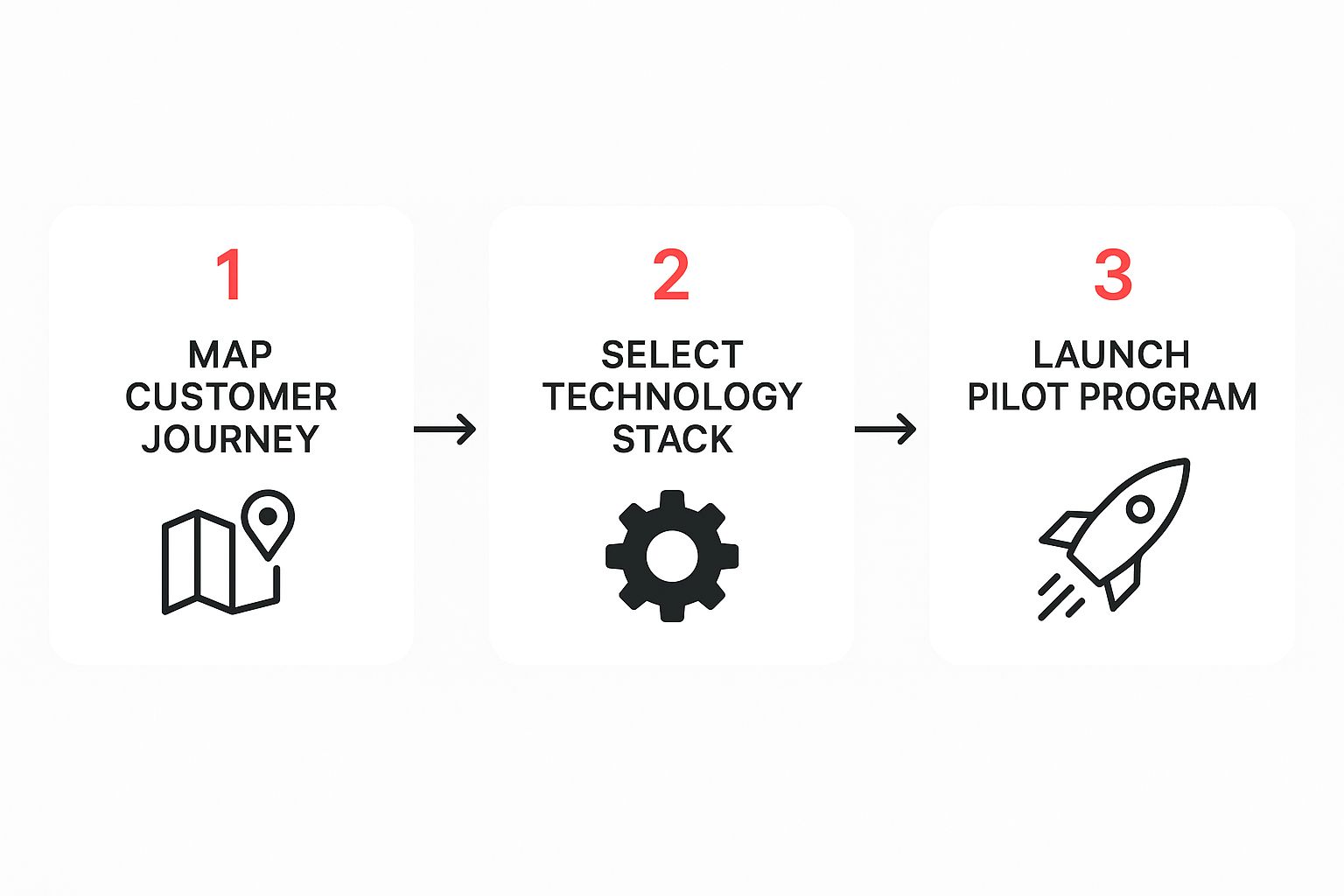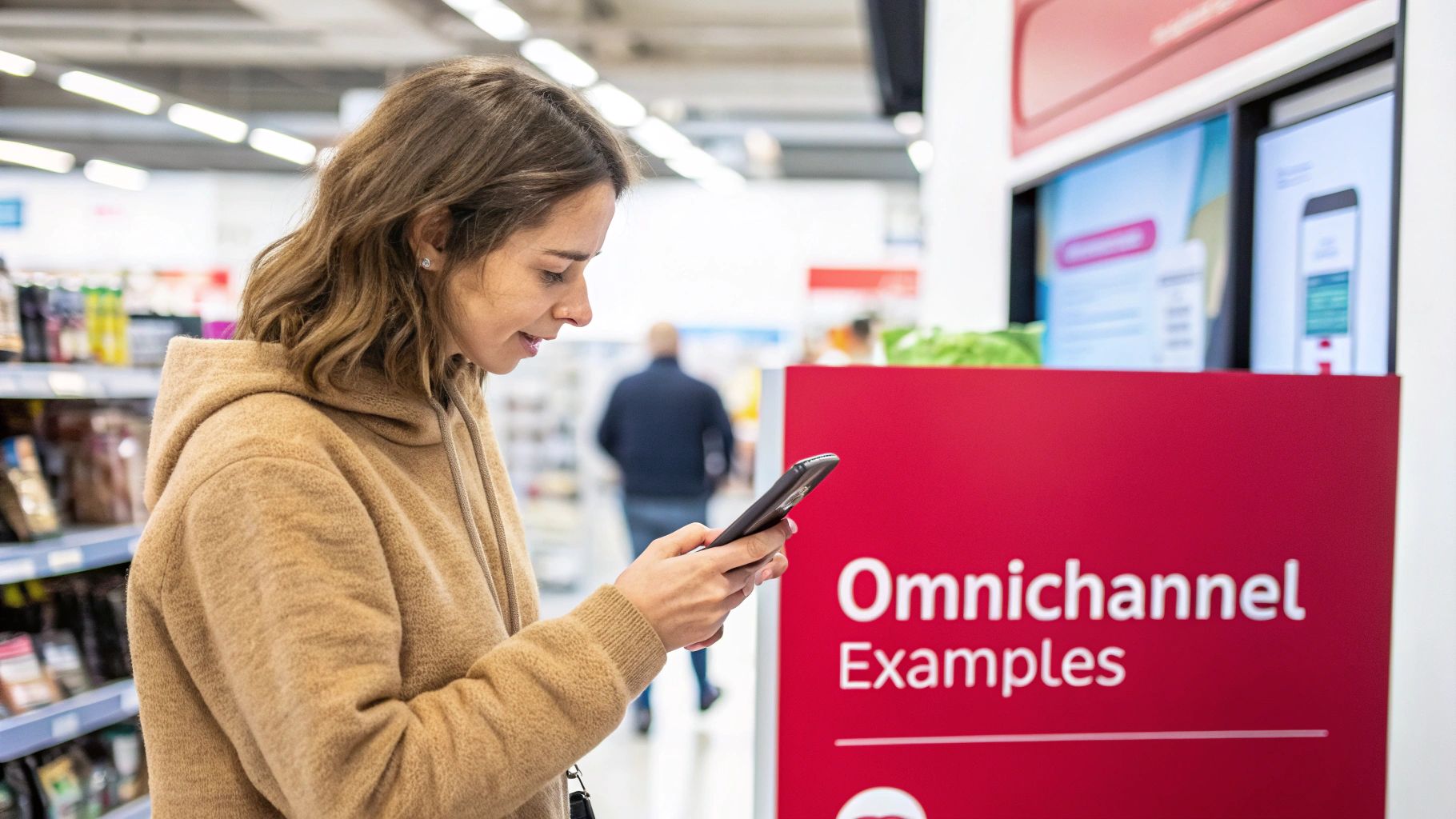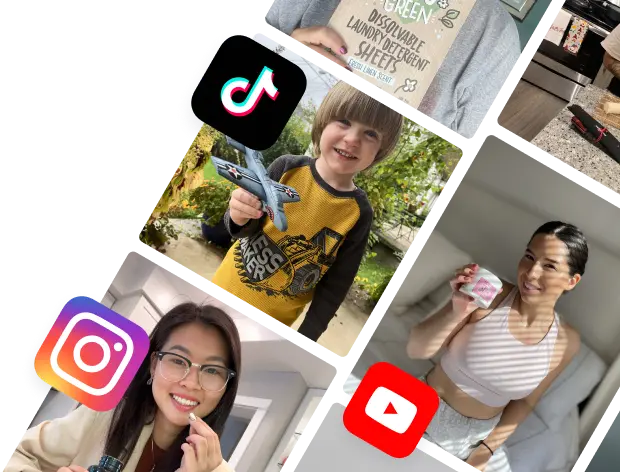 Why Authenticity Beats Perfection in Modern Marketing
Why Authenticity Beats Perfection in Modern Marketing
Let's be honest, "omnichannel marketing" gets thrown around a lot. But what does it actually mean in practice?
Simply put, an omnichannel strategy connects all your customer touchpoints—from a TikTok ad to an in-store visit—into one cohesive, intelligent experience. It's not just about having a presence on multiple channels; it's about making them talk to each other so the customer journey feels effortless.
Table of Contents
What Is Omnichannel Marketing Really About?

Think of your marketing efforts like an orchestra. Each channel—your website, mobile app, email list, physical store, social media—is an instrument. When every instrument plays its own tune without listening to the others, you get noise. That disconnected approach is called multichannel marketing.
An omnichannel marketing strategy, on the other hand, is the conductor. It makes sure every instrument plays in perfect harmony to create one beautiful piece of music: the customer experience. The customer doesn't just hear the violin or the cello; they get the full impact of the entire symphony. For a deeper dive into the fundamentals, you can explore this great piece on what omnichannel marketing truly entails.
The Shift From Linear to Fluid Journeys
The old path to purchase was pretty straightforward. A customer saw a TV ad, went to a store, and bought something. Easy.
Today’s customer journey is a tangled, fluid web. A modern shopper might:
- Discover a product scrolling through TikTok on their phone.
- Jump over to their laptop to read reviews.
- Head to a physical store to see the item up close.
- Finally, pull out their phone again to buy it through the brand's app for a discount.
This zig-zagging path means isolated channels just create friction. When a customer has to re-enter their shipping info, explain an issue to three different support reps, or sees conflicting prices online and in-store, the experience falls apart. That frustration is exactly what an omnichannel strategy fixes.
An omnichannel approach isn't about being everywhere. It's about being unified everywhere you are. It recognizes that the customer is the channel, and their journey flows between the online and offline worlds without a second thought.
Solving the Disconnected Experience
At its core, an omnichannel marketing strategy tears down the walls between your marketing, sales, and customer service teams. By integrating your data and tech stack, you create a single, ongoing conversation with your audience, no matter where they interact with your brand.
For DTC brands and e-commerce agencies, this is where the magic happens. A customer's abandoned cart on your website can trigger a follow-up email and a retargeting ad on Instagram. It means the in-store associate can see a customer's online wishlist, offering a genuinely helpful experience that builds real loyalty and, of course, drives more sales.
Why an Omnichannel Approach Is No Longer Optional
Let's be real: thinking about your marketing in terms of separate channels is a fast track to becoming irrelevant. Your customers don't see your brand as "the website," "the app," and "the physical store." To them, you're just one brand, and they expect a single, coherent experience no matter where they interact with you.
Shifting to a customer-obsessed mindset isn't just a trendy upgrade; it’s a fundamental requirement for growth. A disconnected experience is a direct path to lost revenue. An omnichannel strategy is the connective tissue that holds the entire customer journey together, making every interaction feel smooth and intuitive.
Think about it. A shopper browses on their laptop, adds a few things to their wishlist on their phone during their commute, and then walks into your store. An associate pulls up that very same wishlist and makes a personalized recommendation. That’s not just convenient; it’s magic. It makes customers feel seen and understood, turning a simple transaction into a real relationship.
Boost Customer Retention and Lifetime Value
We all know acquiring a new customer is wildly expensive compared to keeping one you already have. This is where an omnichannel approach really proves its worth. By creating a unified, positive experience across every touchpoint, you give customers compelling reasons to stick around.
The numbers don't lie. Companies with strong omnichannel customer engagement strategies retain an average of 89% of their customers. For companies with weak strategies? That number plummets to just 33%.
That's a massive difference. It shows that loyalty isn't just about a good product; it's about the entire ecosystem a customer interacts with. A well-executed omnichannel strategy makes every single one of those interactions count, which naturally drives up customer lifetime value (LTV). Happy, loyal customers don't just come back—they spend more over time. This makes an omnichannel approach one of the top strategies for customer retention for any brand serious about long-term growth.
A Deeper Understanding Through Unified Data
Beyond the immediate customer-facing perks, an omnichannel strategy delivers an incredible asset: a complete, 360-degree view of your customer. When your channels operate in silos, so does your data. Your social media team sees one piece of the puzzle, your e-commerce team sees another, and your retail team sees a third. Nobody has the full picture.
An omnichannel framework shatters those data silos. It pulls information from every touchpoint into a single, centralized profile, finally revealing how customers actually behave.
- Website Analytics: What pages are they lingering on? Where are they dropping off?
- Mobile App Usage: Which features do they love? What are they buying in-app?
- Social Media Interaction: What ads are they clicking? What content do they engage with?
- In-Store Purchases: Can you connect that offline purchase to their online profile?
- Customer Support Logs: What problems are they running into? What questions do they ask?
This unified data is a goldmine. You can finally move beyond generic marketing blasts and start delivering hyper-relevant messages based on a customer’s entire history with your brand. Imagine sending a push notification about a new arrival to someone who was just browsing that exact category on your website an hour ago. That's powerful.
This isn't just a theory; it reflects how people shop today. Around 73% of retail shoppers now use multiple channels during their buying journey, interacting with a brand at an average of six touchpoints before making a purchase. With that kind of complexity, a unified strategy is the only way to connect the dots and truly understand the path to conversion.
The Core Components of a Powerful Omnichannel Strategy

Pulling off a true omnichannel strategy takes more than just good intentions. It demands a solid foundation built on a few key, interconnected parts. Think of it like building a high-performance engine—each piece needs to be precisely engineered and work in perfect sync to generate real power.
If you skip these core pillars, your strategy will just sputter out. You’ll end up with a collection of disconnected channels instead of that seamless customer experience you’re aiming for. Let's break down the essential building blocks that make a powerful omnichannel machine run smoothly.
The Centralized Customer Data Platform
The heart of any effective omnichannel strategy is a Centralized Customer Data Platform (CDP). Don't think of it as just another database; it’s the central nervous system for your entire marketing operation. Its job is to collect, clean, and unify customer data from every single touchpoint.
A good CDP pulls in information from all over the place:
- Website: Page views, clicks, and time spent on site.
- Mobile App: In-app behavior and purchase history.
- Email Marketing: Open rates, click-throughs, and campaign responses.
- Social Media: Ad interactions and direct engagement.
- Point-of-Sale System: In-store purchase data.
- Customer Service Software: Support tickets and chat logs.
By bringing all this information together, a CDP creates a single, 360-degree profile for each customer. This unified view is the secret sauce that makes genuine personalization possible, letting you understand and even anticipate what your customers need with surprising accuracy.
Consistent Branding And Messaging
Imagine seeing a sleek, minimalist ad for a brand on Instagram. You click through, only to land on a loud, cluttered website. Then you get a formal, corporate-sounding email from them. It’s jarring, right? That kind of inconsistency kills brand trust instantly.
Consistency is the glue that holds your omnichannel experience together. This is about more than just using the same logo and colors. It means maintaining a consistent:
- Tone of Voice: Whether your brand is playful, professional, or inspirational, that personality should shine through on every channel.
- Visual Identity: Use the same fonts, imagery, and design style across your website, social profiles, emails, and even physical store signage.
- Core Messaging: Your value proposition and key brand promises have to be crystal clear and unwavering, no matter where a customer bumps into them.
When you nail this uniformity, the conversation with your customer feels like a continuation as they move between channels, not a bunch of separate, random interactions. It builds familiarity and reinforces who you are at every step.
Integrated Technology And Channel Automation
Your tech stack is basically the plumbing that allows data to flow freely between your different systems. If your e-commerce platform doesn’t talk to your CRM, or your email tool is isolated from your social media ads manager, you create data silos. An omnichannel strategy simply cannot survive in a siloed environment.
True omnichannel execution relies on an ecosystem of integrated tools. The goal is to create a technology stack where each platform can share data and trigger actions in another, creating a seamless operational backbone.
For example, a customer abandoning their cart on your Shopify store should automatically kick off a workflow. That could mean sending a follow-up email through Klaviyo while simultaneously adding that user to a custom retargeting audience on Facebook. To make that happen, your tools have to be connected. This is where powerful platforms for e-commerce marketing automation become indispensable, as they’re designed to handle these kinds of cross-channel workflows and make complex interactions feel effortless.
A Customer-Centric Organizational Mindset
Finally—and this might be the most important piece of the puzzle—a successful omnichannel strategy requires a huge cultural shift within your organization. This isn't just a marketing project; it’s a business-wide commitment to putting the customer at the absolute center of every single decision.
This means tearing down the traditional walls between departments:
- Marketing needs to know what issues customers are reporting to the support team.
- Sales should be able to see which marketing campaigns a new lead has engaged with.
- Customer Service agents must have access to a customer’s full purchase history and recent website activity.
When everyone is looking at the same customer data and working toward the shared goal of creating a frictionless journey, the entire organization becomes an engine for amazing customer experiences. This collaborative mindset is the fuel that powers every other component, turning a complex plan into a real-world advantage.
How to Build Your Omnichannel Marketing Strategy Step by Step
Putting together a real omnichannel strategy isn't something you can knock out in a weekend. It's a fundamental shift, moving your entire business from thinking about channels to thinking about the customer. The goal is to get all your channels working together in perfect harmony, not competing for attention.
This guide will walk you through the essential stages of building a strategy that creates a genuinely seamless and valuable experience for your customers. Let's get into it.
Map the Complete Customer Journey
You can't fix an experience you don't fully understand. The first and most critical step is mapping the customer journey—visualizing every single interaction a person could have with your brand, from the first time they hear your name to the moment they need support after a purchase.
Forget simple conversion funnels. This map needs to be a detailed web of all the different touchpoints, both online and off.
- Awareness: How do they find you? A TikTok that went viral, a late-night Google search, or a recommendation from a friend?
- Consideration: What's the next move? Do they dive into blog reviews, scroll through your Instagram feed, or compare prices on their laptop?
- Purchase: Where does the transaction happen? Is it through your mobile app, inside a physical store, or by clicking a link in an email newsletter?
- Service & Loyalty: What happens after the sale? Do they hit up your live chat for help, leave a glowing review, or sign up for your loyalty program?
By charting all these possible paths, you’ll quickly spot the friction points—the places where the experience feels clunky or disconnected. This map becomes your blueprint for improvement, showing you exactly where a more integrated approach will make the biggest difference.
Segment and Personalize Your Audience
With your journey map in hand, you can start to understand the different kinds of people taking those journeys. A one-size-fits-all message just doesn’t cut it anymore. Audience segmentation is all about grouping your customers based on shared traits and behaviors.
You can group your audience by:
- Demographics: The basics like age, location, and gender.
- Behavioral Data: Things like purchase history, which pages they visited on your site, and how they use your app.
- Psychographics: Deeper insights into their interests, values, and lifestyle.
Once you have these segments, you can start delivering personalized experiences that actually connect. A first-time visitor might get a welcome discount, while a long-time loyal customer gets an exclusive first look at a new collection. This kind of personalization shows your customers that you get them, which builds a much stronger bond and keeps them coming back. If you want more ideas, our guide on building a multi-channel marketing campaign has some great insights into audience targeting.
Choose and Integrate the Right Technology
Your tech stack is the backbone of your entire omnichannel strategy. It's the engine that lets data flow seamlessly between channels, making all those consistent experiences possible. The key word here is integration.
All your core systems need to talk to each other. This usually means connecting your:
- Customer Relationship Management (CRM): Your central hub for all customer data and interactions.
- Customer Data Platform (CDP): A more powerful system that pulls customer data from every source into one unified profile.
- E-commerce Platform: Your online store, like Shopify or BigCommerce.
- Marketing Automation Software: Tools that handle your email, SMS, and other automated messages.
- Help Desk Software: Platforms for managing customer support tickets and conversations.
When these systems are properly connected, you can do some pretty amazing things. For example, a customer support ticket can instantly show the agent that customer's recent purchase history from your e-commerce platform, leading to smarter, faster service.
The right tech stack doesn't just collect data; it activates it. It turns insights from one channel into immediate, personalized actions on another, creating a responsive and intelligent customer journey.
The infographic below shows how these pieces fit together, from mapping the journey to picking the right tools and getting your first test off the ground.

This process shows how a deep understanding of the customer journey should directly influence your technology choices, which in turn paves the way for a successful pilot program.
Align Your Teams and Foster Collaboration
Great technology can only get you so far. Your company culture is just as important. A true omnichannel experience requires you to break down the silos that usually exist between marketing, sales, customer service, and even your in-store staff. Everyone needs to work together and share information to serve the customer as one cohesive unit.
Training is a must. A customer service rep, for example, needs to see what marketing campaigns a customer has interacted with to understand the full context of their question. It's wild, but 56% of customers say they have to repeat their issue to multiple support agents—a classic sign of disconnected channels. But when you get it right, the payoff is huge. Omnichannel systems can boost customer satisfaction scores to 67%, a massive jump from the 28% seen in siloed, multichannel setups. You can discover more insights about customer service statistics and see the impact for yourself.
This alignment ensures everyone is on the same page, working toward the same goal: delivering an amazing customer experience.
Launch a Pilot Program and Iterate
Finally, whatever you do, don't try to launch everything at once. A "big bang" approach is incredibly risky and you'll miss out on valuable lessons along the way. Instead, start small with a pilot program. Focus on one specific customer segment or just a couple of integrated channels.
For example, you could start by connecting your website's abandoned cart data to your email marketing tool to trigger a personalized follow-up series. Track everything—open rates, conversion rates, and any customer feedback you get.
This test-and-learn approach allows you to:
- Validate your assumptions on a manageable scale.
- Find and fix any technical bugs before they impact your entire customer base.
- Gather real-world data to make your strategy even smarter.
- Showcase some early wins to build momentum and get buy-in for a wider rollout.
Use what you learn from the pilot to make improvements, and then gradually expand your omnichannel efforts. Building methodically on a foundation of proven results is the key to long-term success.
Omnichannel Marketing Examples from Leading Brands
Theory is one thing, but seeing a masterful omnichannel strategy in action is where the real lightbulbs go off. Some of the world’s biggest brands have perfected the art of creating a single, fluid conversation with their customers, no matter where they are. Let’s break down how a couple of the best in the business do it.
By looking at these real-world examples, you can borrow proven tactics and see how a unified experience builds incredible customer loyalty and drives growth. These aren’t just clever campaigns; they are deeply integrated systems built entirely around the customer.
Starbucks: The Master of Mobile Integration
Starbucks is the classic case study for omnichannel excellence, and for good reason. Its mobile app isn't just an app; it's the central hub of the entire customer experience. It’s a seamless extension of the in-store visit, designed to add convenience and value at every single step. They’ve brilliantly merged their physical and digital worlds.
A typical Starbucks run might look something like this:
- Mobile Order & Pay: You use the app to order your go-to drink while you’re on the way, completely skipping the line.
- Personalized Offers: The app pings you with a push notification for a "buy one, get one free" offer on a pastry you've bought before. It knows you.
- In-Store Pickup: You walk in, grab your pre-paid order from the counter, and the barista greets you by name.
- Loyalty Rewards: That purchase automatically adds "Stars" to your rewards account, which you can see update in real-time right in the app.
This screenshot of the Starbucks Rewards dashboard shows just how central the app is—rewards, payment, and ordering are all in one clean interface.

The real magic here is the complete removal of friction. The app basically acts as a remote control for the physical store, making every interaction faster, easier, and more rewarding.
Starbucks doesn't just sell coffee; it sells convenience. This is all powered by a deeply integrated ecosystem where the app, the rewards program, and the in-store experience work in perfect harmony to make you feel recognized and valued.
Sephora: Blending Digital and Physical Beauty
Sephora has been a trailblazer in using tech to make shopping better for years. The brand gets that buying beauty products is a personal, hands-on process. Their omnichannel strategy brilliantly closes the gap between browsing online and discovering products in-store.
Their entire strategy is built on a few key pillars:
- Beauty Insider Program: This loyalty program is the connective tissue for everything. Your online purchase history, your "Loves" list, and your in-store buys are all tracked in one unified account.
- Virtual Artist Tool: Using augmented reality (AR) in their mobile app, you can virtually "try on" thousands of makeup products from your couch. This solves one of the biggest headaches of buying cosmetics online.
- In-Store Technology: Store associates are armed with devices that can pull up your Beauty Insider profile. This allows them to see past purchases and preferences to give you hyper-personalized recommendations on the spot.
Sephora’s success comes from using technology not as a gimmick, but as a genuine tool to help customers make more confident decisions. Whether you're at home or standing in an aisle, you have access to the same powerful tools and personalized data, creating a truly consistent brand experience.
Measuring the Success of Your Omnichannel Efforts
Let's be real: an omnichannel marketing strategy is a serious investment. You're putting in time, tech, and a whole lot of resources. To make sure it’s all worth it—and to keep getting better—you need a rock-solid way to measure its impact. We're talking about going way beyond vanity metrics like social media likes. It's about focusing on the numbers that actually signal business health and customer happiness.
Good measurement tells you what's working, what's a waste of money, and where you should double down. Without clear data, you're just flying blind.
Core Metrics for Omnichannel Success
To really see the big picture, you need to track a mix of metrics that cover everything from customer loyalty to cold, hard cash. These KPIs will give you a clear view of how your unified approach is actually changing customer behavior and pushing your business forward.
Here are a few must-haves for your dashboard:
- Customer Lifetime Value (CLV): This is the total amount of money you can expect a single customer to spend with you. When your CLV is climbing, it's a huge sign that your seamless experience is keeping people coming back for more.
- Customer Retention Rate: This one is simple: it’s the percentage of customers who stick around over a certain period. Brands with strong omnichannel plays almost always have higher retention rates. It just proves that a connected experience creates loyalty.
- Conversion Rate by Channel: Even though the goal is a unified experience, you still need to know how each channel is pulling its weight. This helps you figure out which touchpoints are the real closers when it comes to making a sale.
- Average Order Value (AOV): This tracks how much customers spend, on average, every time they place an order. A killer omnichannel strategy often pumps up AOV because smart recommendations and a smooth journey make it easy for shoppers to add just one more thing to their cart.
Understanding Attribution and Contribution
One of the trickiest parts of measuring omnichannel marketing is figuring out how all your channels work together to land a sale. A customer might see a Facebook ad, click a link in an email, and finally buy something through your mobile app. So, who gets the credit?
This is where attribution modeling becomes your best friend. Instead of just giving 100% of the credit to the very last thing a customer did (last-click attribution), smarter models give you a much more realistic picture of the entire journey.
More sophisticated models, like data-driven or time-decay attribution, help you assign the right amount of credit to every single interaction that nudged the customer toward buying. Getting a handle on these different approaches is a game-changer, and you can learn more about how different multi-channel attribution models can shape your measurement strategy. When you can see the full path clearly, you can make smarter calls about where to put your marketing dollars, fueling the channels that truly drive value from that first look to the final click.
Got Questions About Omnichannel Marketing?
Even the best-laid plans come with questions. When you're shifting your marketing approach, it's natural for a few things to pop up. Let's tackle some of the most common ones we hear about building a solid omnichannel strategy.
The idea here is to clear up the confusion and give you some quick, practical answers you can run with, no matter the size of your business.
Omnichannel vs. Multichannel: What's the Difference, Really?
The single biggest difference comes down to the customer's point of view. Think of multichannel like having separate conversations in different rooms of your house. You might talk to a brand on Instagram, then later via email, but those two chats are completely disconnected from each other.
An omnichannel marketing strategy, on the other hand, is one single conversation that follows the customer from room to room. It puts the customer at the absolute center, making sure their experience feels connected and consistent, no matter where they choose to interact with you.
Multichannel is having a presence in every room. Omnichannel is having one seamless conversation that moves with the customer from room to room without ever missing a beat.
How Can a Small Business Get Started with This?
You don't need a massive budget to start thinking omnichannel. The best first step is to simply connect the channels you already own and control—think your e-commerce store, your email list, and your social media accounts.
Focus on creating one simple, high-impact connection first. For example, take a customer's purchase history from your Shopify store and use it to send a highly personalized follow-up email with genuinely useful product recommendations. That simple link between just two channels is the first building block of a powerful strategy.
What Are the Most Common Roadblocks I'll Face?
Making the leap to a true omnichannel model isn't always a walk in the park. You'll likely run into a few common hurdles, but just knowing what they are is half the battle.
- Data Silos: This is a classic. Your customer data is stuck in different systems (your e-commerce platform, your CRM, your email tool) and none of them talk to each other.
- Tech Integration Headaches: Getting all your different software to play nicely and share data can feel like herding cats. It can get technically complex, fast.
- Internal Resistance: Sometimes the biggest challenge is human. Your teams are used to working in their own lanes (the email team does email, the social team does social) and might push back against the collaboration required.
Getting past these usually means investing in a central data platform (like a CDP), picking tech that’s built to integrate well with others, and most importantly, building a company culture that is relentlessly focused on the customer's total experience.








